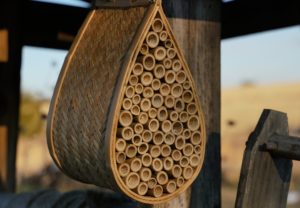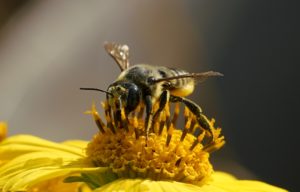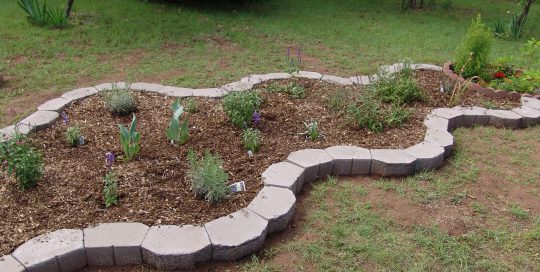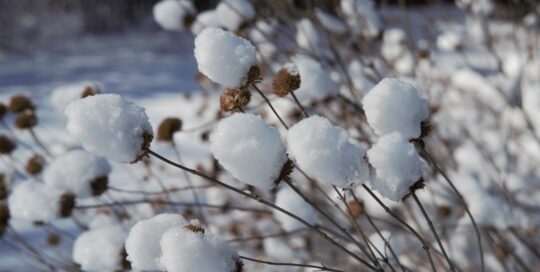Solitary Bee Houses are Great Additions to a Garden…with a Caveat
Views: 7823

A few years ago, a friend gave me a solitary bee house. I didn’t put my gift up right away because I read some information online that indicated the type of house I was given might not be very good for the bees, and I needed to do more research on the topic before putting it out. And, indeed, it turns out that solitary bee houses are great…with a caveat. So, here’s what you need to know.
What are Solitary Bees?
Unlike social bees such as European honey bees, solitary bees don’t share resources or form group nests or hives. They go about living their bee lives without help from any other bees. While some solitary bees will nest near each other, each female will build her nest, lay her eggs, and provide for her offspring without assistance.
Most native North American bees are solitary bees, with some exceptions like bumble bees and certain sweat bees. Typically, they produce one generation per year, each emerging at the same time of year as their parents did. Solitary bees are not aggressive, and they rarely sting.
Mason bees and leafcutter bees are solitary bees that utilize bee houses. Most other solitary bees build their nests underground.
Why Do You Want Them?
Although honey bees get the most credit for pollinating our agricultural crops, solitary bees are important pollinators, too. In fact, since they have evolved together, there is growing evidence that native bees may be more effective at pollinating native plants than honey bees. So, if you have a vegetable garden with native plants such as tomatoes, squash, and peppers, having native bees around may boost your production.
Me? I just love watching them wallow around in my flowers.

A leafcutter bee
About Solitary Bee Houses
Chances are you’ve seen solitary bee houses for sale at your local garden center. Typically, they consist of a frame filled with hollow tubes made of bamboo, cardboard, paper, or other porous material. A female solitary bee will lay her eggs in cells inside the tube or tunnel. Each cell is provisioned with food for the larva. This food consists of a combination of pollen and nectar.
A single bee may use several tubes in a house, but other solitary bees may use the house at the same time. Some houses provide different sizes of tubes to attract a variety of bee species.
What is the Potential Problem?
The primary concern is that unmaintained bee houses may become breeding grounds for pathogens and bee pests, like mites. So, bee houses that are put out and never cleaned may become death traps. If you have a bee house, it needs to be maintained and/or cleaned occasionally.
What Makes a Good, Safe Bee House?
The best bee houses have replaceable tubes or liners. Some bee house brands offer replacement kits specifically designed for their houses, but it’s also possible to make your own by using paper straws or cutting other hollow, porous tubes to the size you need.
Tubes should be 5-8 inches long, and 1/8” to 1/2” in diameter.
Most bee houses also have some sort of overhang to keep water from dripping in the openings, but this isn’t strictly necessary.
Mount or hang it facing the south or southeast to provide early morning warmth.
It’s best to have a solid back on the house, so tubes only have a single entrance. While bees can plug both ends of a tube/tunnel, the more openings, the more opportunities for predators to enter and things to go wrong.
How Often Should I Clean My Bee House?
Replace your tubes or liners at least every two years to prevent pathogen buildup.
I did find one comprehensive, reliable, online source that suggested you could clean fixed-tunnel bee houses with a 50% bleach solution to kill harmful pathogens. So, for those of us with less-than-ideal houses, this may be an option.
Of course, you don’t want to harm any bees when you do this, so ensure all tubes are empty before cleaning or replacing. One way to do this is to use an emergence chamber. In late winter, place the bee house in an empty box. Cut a hole in the top or side that is big enough for the bees to see light and escape, but small enough that no bees are likely to find their way in again to nest. Place the box in a dry, sheltered area until the bees have emerged and the nests are empty, sometime in summer. Then you can proceed with cleaning the house.
Some people have two houses. This allows them to have a house in the cleaning cycle and a house that is in active use.
Other Ways to Help Solitary Bees
There are other, simple ways to help solitary bees. Your garden probably produces natural nesting sites in the form of hollow or pithy stems such as flower stalks and reeds. Instead of throwing these away or composting them, you can put them in an undisturbed part of your yard or a brush pile. Native bees will find them and use them just like they would a bee house. You can also leave dead wood or logs in place. After other insects have bored holes and tunnels into the decaying wood, bees will use these holes as nesting sites. I’ve seen nature centers drill holes in dead logs for bees. (I wonder if they, too, are inviting pathogen problems if left untended over time. But bees use holes in logs naturally, so perhaps not.)

Solitary bee house at a nature center
Since many native bees nest underground, avoid tilling, and protect areas where you have noticed bee activity or nests.
Leaf piles, dead wood, discarded plant bits… leaving this detritus around can benefit wildlife in numerous ways, including providing nesting sites for our native bees. You don’t have to have a cluttered landscape, just set aside a corner for a little untidiness.
Meet Leslie Miller
Leslie Ann Miller shares 3.5 acres in rural Oklahoma with birds, butterflies and wide variety of animals. She is currently transforming her yard with plantings…
Leslie's Recent Posts

Firescaping 101






